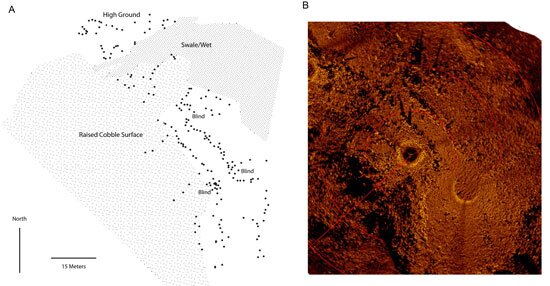
According to the results of an underwater archaeological investigation conducted by a multidisciplinary team of researchers, rock structures located on a ridge beneath Lake Huron indicate probable evidence of organized seasonal caribou hunting more than 9,000 years ago.
Known as the submerged Alpena-Amberley Ridge (AAR), it provided a dry land bridge between Michigan and Ontario 9,000 years ago. Using sonar surveys, investigation by a remotely operated vehicle (ROV), and scuba-equipped underwater archaeologists, team leader John O’Shea of the Museum of Anthropological Archaeology, University of Michigan, and colleagues identified ancient human-made structures on the ridge, structures that they suggest were likely used for caribou hunting.
One such site, called the Drop 45 Drive Lane, consists of two parallel rock-lined paths, suggested by the researchers to have been used to funnel caribou into an 8-meter-wide lane. They also identified what they call V-shaped hunting blinds set above the lane on a hill. Scuba-trained archaeologists recovered eleven flakes of chert, typical byproducts of stone tool repair or maintenance.
Scientists have long theorized that paleoindian and archaic indian hunters pursued and entrapped their prey by using cooperative, organized techniques, requiring a sophisticated level of social interaction and planning. Write O’Shea and colleagues in their report:
Humans and caribou have a long history of interaction, dating back to at least the Middle Paleolithic. Over time, caribou hunters and herders became aware of the tendency of caribou, like many ungulates, to follow linear features. As such, the construction of linear features of stone or brush provides an effective means of channeling the movement of animals into predetermined kill zones. Numerous historical and ethnographic examples of these hunting structures and associated features are known in the Arctic. In more temperate regions of the globe, traces of such structures rarely survive intact.*
More than the Drop 45 Drive Lane itself, the findings show an interrelated complex of drive lanes, multiple blinds and auxiliary structures that served together as an integrated system for controlling the prey into a kill zone. The findings, say the researchers, have implications for understanding the social and economic organization of the ancient hunters that used the AAR, as it required large groups of cooperating hunters and smaller groups of families to operate the system.
_______________________________
A plan of the Drop 45 Drive Lane site (A) alongside a sonar image of the site (B). The black circular area is the scanning unit, and the red circles denote increasing radii of 15 meters. Credit: Image courtesy of John O’Shea/ UMMAA.
_______________________________
A V-shaped hunting blind beneath Lake Huron. Credit: Image courtesy of John O’Shea/ UMMAA.
_______________________________
What is most significant about the discovery, according to the study authors, is that it offers a unique window into the organization of prehistoric hunting for a time period that is very poorly known from terrestrial sites in the Great Lakes region. It further demonstrates that archaeological sites of great antiquity are preserved underwater and that they have the potential to fill important gaps in our understanding of the deep human past.
The detailed study is published in the Proceedings of the National Academy of Science Early Edition.
*Article #14-04404: “A 9,000-year-old caribou hunting structure beneath Lake Huron,” by John M. O’Shea, Ashley K. Lemke, Elizabeth P. Sonnenburg, Robert G. Reynolds, and Brian D. Abbott.
Extensively adapted, supplemented, and edited from a press release.
_____________________________
Read about the most fascinating discoveries with a premium subscription to Popular Archaeology Magazine. Find out what Popular Archaeology Magazine is all about. AND MORE:
On the go? Purchase the mobile version of the current issue of Popular Archaeology Magazine here for only $2.99.
Popular Archaeology’s annual Discovery Edition eBook is a selection of the best stories published in Popular Archaeology Magazine in past issues, with an emphasis on some of the most significant, groundbreaking, or fascinating discoveries in the fields of archaeology and paleoanthropology and related fields. At least some of the articles have been updated or revised specifically for the Discovery edition. We can confidently say that there is no other single issue of an archaeology-related magazine, paper print or online, that contains as much major feature article content as this one. The latest issue, volume 2, has just been released. Go to the Discovery edition page for more information.







